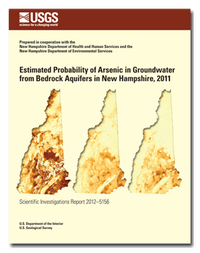Estimated probability of arsenic in groundwater from bedrock aquifers in New Hampshire, 2011
Links
- More information: USGS Index Page
- Document: Report (2.70 MB pdf)
- Companion File: Geospatial data (122 MB zip)
- Download citation as: RIS | Dublin Core
Abstract
Probabilities of arsenic occurrence in groundwater from bedrock aquifers at concentrations of 1, 5, and 10 micrograms per liter (µg/L) were estimated during 2011 using multivariate logistic regression. These estimates were developed for use by the New Hampshire Environmental Public Health Tracking Program. About 39 percent of New Hampshire bedrock groundwater was identified as having at least a 50 percent chance of containing an arsenic concentration greater than or equal to 1 µg/L. This compares to about 7 percent of New Hampshire bedrock groundwater having at least a 50 percent chance of containing an arsenic concentration equaling or exceeding 5 µg/L and about 5 percent of the State having at least a 50 percent chance for its bedrock groundwater to contain concentrations at or above 10 µg/L. The southeastern counties of Merrimack, Strafford, Hillsborough, and Rockingham have the greatest potential for having arsenic concentrations above 5 and 10 µg/L in bedrock groundwater.
Significant predictors of arsenic in groundwater from bedrock aquifers for all three thresholds analyzed included geologic, geochemical, land use, hydrologic, topographic, and demographic factors. Among the three thresholds evaluated, there were some differences in explanatory variables, but many variables were the same. More than 250 individual predictor variables were assembled for this study and tested as potential predictor variables for the models. More than 1,700 individual measurements of arsenic concentration from a combination of public and private water-supply wells served as the dependent (or predicted) variable in the models.
The statewide maps generated by the probability models are not designed to predict arsenic concentration in any single well, but they are expected to provide useful information in areas of the State that currently contain little to no data on arsenic concentration. They also may aid in resource decision making, in determining potential risk for private wells, and in ecological-level analysis of disease outcomes. The approach for modeling arsenic in groundwater could also be applied to other environmental contaminants that have potential implications for human health, such as uranium, radon, fluoride, manganese, volatile organic compounds, nitrate, and bacteria.
Study Area
| Publication type | Report |
|---|---|
| Publication Subtype | USGS Numbered Series |
| Title | Estimated probability of arsenic in groundwater from bedrock aquifers in New Hampshire, 2011 |
| Series title | Scientific Investigations Report |
| Series number | 2012-5156 |
| DOI | 10.3133/sir20125156 |
| Year Published | 2012 |
| Language | English |
| Publisher | U.S. Geological Survey |
| Publisher location | Reston, VA |
| Contributing office(s) | New England Water Science Center |
| Description | Report: vi, 25 p.; Geospatial Data |
| Country | United States |
| State | New Hampshire |
| Online Only (Y/N) | Y |
| Additional Online Files (Y/N) | Y |


